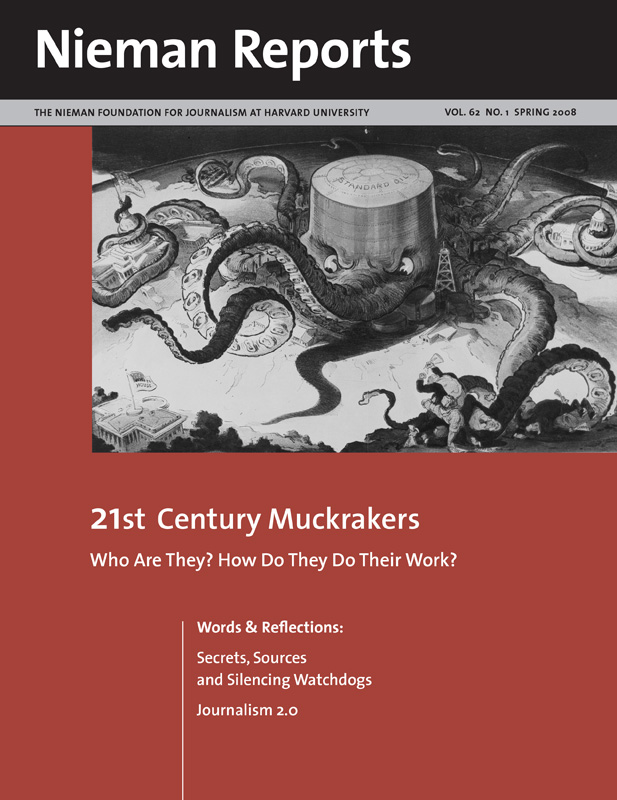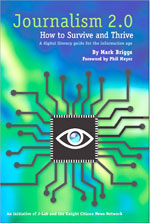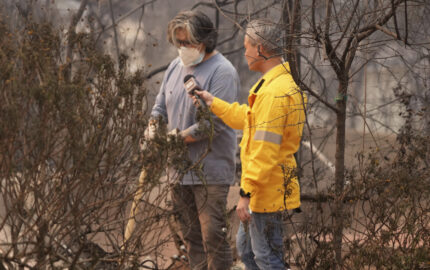News organizations throughout the world require journalists to report for multiple platforms, including the Web. In my role as a journalism professor at the University of Hong Kong and the faculty member responsible for our core New Media Workshop, it is my job to fully prepare our students for this reality. This means no one graduates without basic Web literacy and exposure to the tools and methods of online storytelling.
EDITOR'S NOTE
Journalism 2.0 was commissioned by J-Lab: The Institute for Interactive Journalism as a learning module for the Knight Citizen News Network (www.kcnn.org). It was written by Mark Briggs and edited by J-Lab’s Jan Schaffer. Download a free pdf. Purchase a hard copy of the book for $12 »With media technology changing rapidly from month-to-month, it is hard to find classroom texts to support our teaching. Slow-churning wheels of textbook publishing can’t keep up. This means that traditional textbook publishing currently plays no role in my introductory new media class. Instead, I depend on nonprofit organizations and other academic institutions—and the foundations that support them—who are assembling valuable teaching resources quickly and publishing them online for free.
Before I began teaching online journalism at the University of Hong Kong in January 2007, I researched exhaustively to see what textbooks and references other online journalism courses have been using. All that I could find were badly out of date—with the newest one widely used in journalism programs and recommended by UNESCO for international use being James Foust’s “Online Journalism: Principles and Practices of News for the Web,” published in 2005. His book is solid and covers some of the things I needed to do in my classes, but the feedback I got from students during the first semester when I used it was largely negative. They told me it didn’t cover enough of what I taught in my class. The material was not up-to-date enough to justify the cost of the textbook for them.
Journalism 2.0
I was thrilled, therefore, when Mark Briggs’s “Journalism 2.0: How to Survive and Thrive” appeared last summer—downloadable for free online, thanks to the Knight Foundation—whose goal is to educate as many journalists as possible. Subtitled “a digital literacy guide for the information age,” the book is broken down into logical, practical chunks so that the reader can focus on what she finds to be new and quickly skim over what is already known.
“Journalism 2.0” seems targeted at an audience of working journalists in American news organizations who want to update their Web literacy and online reporting skills. From where I sit in Hong Kong, it does not appear to have been written with news organizations beyond the United States and perhaps Western Europe in mind, nor does it seem meant as a text for university journalism courses. But it turns out to be a heck of a lot better than nothing, which is what I had when I began teaching last winter. [See accompany box for description of other free online texts and resources.]
The first chapter introduces basic Web concepts, such as the difference between the Internet and the Web. It then describes how browsers work, how to use and read RSS feeds, instant messaging, e-mail groups, and FTP. In the next chapter, it takes us into social networking sites like MySpace and social bookmarking sites like del.icio.us and Technorati. Subsequent chapters deal with gadgets that all journalists should be familiar with and new reporting methods using spreadsheets, databases and a process known as “crowdsourcing.” Later on, specific “how-to’s” occur: how to blog; how to report news for the Web; how to do digital audio and podcasting; how to shoot and manage digital photos; how to shoot video for news and features; how to do basic video editing and, finally, how to write scripts and do voice-overs.
RELATED ARTICLES
“Valued Classroom Resources”
– Rebecca MacKinnon
“Journalists as Storytellers”
– Guillermo FrancoIn structuring my courses, I don’t follow the book’s chapter sequence: I assign different chunks from various sections as needed. I find that the best way to get students started on the Web is to have each of them set up a blog right away. This means I devote my first class to teaching some Web fundamentals, such as introducing browsers and getting their blogs set up. Next we cover RSS so they can discover the feeds that their blogs, as well as all news sites, are generating.
The guidance Briggs provides in his chapter on shooting and editing video offers a good start for people who would like to get a taste for the basics and are good at teaching themselves. But more training and practice are needed for the graduating student to claim that he or she can shoot and edit video to usable standards. Thus, every journalism student is required to take a separate, semester-long video class. In our New Media Workshop, we focus on students learning how to create basic audio-visual slide shows using programs such as Soundslides. Briggs barely mentions the existence of audio-visual slide shows. Given the extent to which news Web sites use such slide shows as a powerful storytelling medium—and that competent audio-visual slide shows are much less difficult to produce than video—it might have been a good idea for him to include a slide show how-to chapter.
Two of Briggs’s chapters—Digital Audio and Podcasting, Shooting and Managing Digital Photos—are excellent basic primers with good tips for recording audio and shooting digital pictures, although I do not find them thorough enough to use on their own as teaching materials. I was also surprised that Briggs made no mention of wikis—other than a brief mention of Wikipedia. All of the nonprofit media startups I’ve been involved with have used wikis as an essential internal collaboration tool, and many news organizations use public wikis as a way to invite public participation in gathering information on stories through crowdsourcing.
RELATED WEB LINK
Download "How to Write for the Web," a Spanish-language book by Guillermo Franco »Despite these issues, even my more Web-savvy students told me that they enjoy Briggs’s book, find it readable and relevant. Nobody has claimed they already knew everything covered in “Journalism 2.0.” I find that even most of the younger graduate students and undergraduates—“digital natives” who are familiar with blogging, Facebook and instant messaging—have given scant thought to their journalistic implications. They might know how to play around and socialize on the Web, but when it comes to applying these skills to serious journalism they still have a lot to learn.
The View From Hong Kong
Because I teach in Hong Kong, half of my graduate students are from mainland China, most of my undergraduates grew up in Hong Kong, and the rest are an international melting pot. Many felt that Briggs’s book fails to recognize that there is a world of journalism beyond the United States.
Several students expressed disappointment that this book does not acknowledge how journalists and citizens can use their new Web skills to fight political censorship as well as indirect commercial pressures that threaten free speech.“Briggs has neglected to mention at any point in his book that the optimism and exchange of ideas rely very much on an information-free and open society,” wrote Elmy Lung, a graduate student and Hong Kong native. “The book addresses none of the problems of how the media might benefit (or even face further suppression) from the Internet in other parts of the world outside the U.S.”
When it comes to preparing the next generation of journalists for the future of news instead of its past, or helping midcareer professionals upgrade their skills, the commercial book publishing industry is unlikely to be the place where teachers or practitioners will turn. Books like Briggs’s “Journalism 2.0” are a valuable, free and instantly accessible addition to a teacher’s toolbox.
Rebecca MacKinnon is an assistant professor at the University of Hong Kong’s Journalism & Media Studies Centre and cofounder of Global Voices, www.globalvoicesonline.org.
EDITOR'S NOTE
Journalism 2.0 was commissioned by J-Lab: The Institute for Interactive Journalism as a learning module for the Knight Citizen News Network (www.kcnn.org). It was written by Mark Briggs and edited by J-Lab’s Jan Schaffer. Download a free pdf. Purchase a hard copy of the book for $12 »With media technology changing rapidly from month-to-month, it is hard to find classroom texts to support our teaching. Slow-churning wheels of textbook publishing can’t keep up. This means that traditional textbook publishing currently plays no role in my introductory new media class. Instead, I depend on nonprofit organizations and other academic institutions—and the foundations that support them—who are assembling valuable teaching resources quickly and publishing them online for free.
Before I began teaching online journalism at the University of Hong Kong in January 2007, I researched exhaustively to see what textbooks and references other online journalism courses have been using. All that I could find were badly out of date—with the newest one widely used in journalism programs and recommended by UNESCO for international use being James Foust’s “Online Journalism: Principles and Practices of News for the Web,” published in 2005. His book is solid and covers some of the things I needed to do in my classes, but the feedback I got from students during the first semester when I used it was largely negative. They told me it didn’t cover enough of what I taught in my class. The material was not up-to-date enough to justify the cost of the textbook for them.
Journalism 2.0
I was thrilled, therefore, when Mark Briggs’s “Journalism 2.0: How to Survive and Thrive” appeared last summer—downloadable for free online, thanks to the Knight Foundation—whose goal is to educate as many journalists as possible. Subtitled “a digital literacy guide for the information age,” the book is broken down into logical, practical chunks so that the reader can focus on what she finds to be new and quickly skim over what is already known.
“Journalism 2.0” seems targeted at an audience of working journalists in American news organizations who want to update their Web literacy and online reporting skills. From where I sit in Hong Kong, it does not appear to have been written with news organizations beyond the United States and perhaps Western Europe in mind, nor does it seem meant as a text for university journalism courses. But it turns out to be a heck of a lot better than nothing, which is what I had when I began teaching last winter. [See accompany box for description of other free online texts and resources.]
The first chapter introduces basic Web concepts, such as the difference between the Internet and the Web. It then describes how browsers work, how to use and read RSS feeds, instant messaging, e-mail groups, and FTP. In the next chapter, it takes us into social networking sites like MySpace and social bookmarking sites like del.icio.us and Technorati. Subsequent chapters deal with gadgets that all journalists should be familiar with and new reporting methods using spreadsheets, databases and a process known as “crowdsourcing.” Later on, specific “how-to’s” occur: how to blog; how to report news for the Web; how to do digital audio and podcasting; how to shoot and manage digital photos; how to shoot video for news and features; how to do basic video editing and, finally, how to write scripts and do voice-overs.
RELATED ARTICLES
“Valued Classroom Resources”
– Rebecca MacKinnon
“Journalists as Storytellers”
– Guillermo FrancoIn structuring my courses, I don’t follow the book’s chapter sequence: I assign different chunks from various sections as needed. I find that the best way to get students started on the Web is to have each of them set up a blog right away. This means I devote my first class to teaching some Web fundamentals, such as introducing browsers and getting their blogs set up. Next we cover RSS so they can discover the feeds that their blogs, as well as all news sites, are generating.
The guidance Briggs provides in his chapter on shooting and editing video offers a good start for people who would like to get a taste for the basics and are good at teaching themselves. But more training and practice are needed for the graduating student to claim that he or she can shoot and edit video to usable standards. Thus, every journalism student is required to take a separate, semester-long video class. In our New Media Workshop, we focus on students learning how to create basic audio-visual slide shows using programs such as Soundslides. Briggs barely mentions the existence of audio-visual slide shows. Given the extent to which news Web sites use such slide shows as a powerful storytelling medium—and that competent audio-visual slide shows are much less difficult to produce than video—it might have been a good idea for him to include a slide show how-to chapter.
Two of Briggs’s chapters—Digital Audio and Podcasting, Shooting and Managing Digital Photos—are excellent basic primers with good tips for recording audio and shooting digital pictures, although I do not find them thorough enough to use on their own as teaching materials. I was also surprised that Briggs made no mention of wikis—other than a brief mention of Wikipedia. All of the nonprofit media startups I’ve been involved with have used wikis as an essential internal collaboration tool, and many news organizations use public wikis as a way to invite public participation in gathering information on stories through crowdsourcing.
RELATED WEB LINK
Download "How to Write for the Web," a Spanish-language book by Guillermo Franco »Despite these issues, even my more Web-savvy students told me that they enjoy Briggs’s book, find it readable and relevant. Nobody has claimed they already knew everything covered in “Journalism 2.0.” I find that even most of the younger graduate students and undergraduates—“digital natives” who are familiar with blogging, Facebook and instant messaging—have given scant thought to their journalistic implications. They might know how to play around and socialize on the Web, but when it comes to applying these skills to serious journalism they still have a lot to learn.
The View From Hong Kong
Because I teach in Hong Kong, half of my graduate students are from mainland China, most of my undergraduates grew up in Hong Kong, and the rest are an international melting pot. Many felt that Briggs’s book fails to recognize that there is a world of journalism beyond the United States.
Several students expressed disappointment that this book does not acknowledge how journalists and citizens can use their new Web skills to fight political censorship as well as indirect commercial pressures that threaten free speech.“Briggs has neglected to mention at any point in his book that the optimism and exchange of ideas rely very much on an information-free and open society,” wrote Elmy Lung, a graduate student and Hong Kong native. “The book addresses none of the problems of how the media might benefit (or even face further suppression) from the Internet in other parts of the world outside the U.S.”
When it comes to preparing the next generation of journalists for the future of news instead of its past, or helping midcareer professionals upgrade their skills, the commercial book publishing industry is unlikely to be the place where teachers or practitioners will turn. Books like Briggs’s “Journalism 2.0” are a valuable, free and instantly accessible addition to a teacher’s toolbox.
Rebecca MacKinnon is an assistant professor at the University of Hong Kong’s Journalism & Media Studies Centre and cofounder of Global Voices, www.globalvoicesonline.org.




